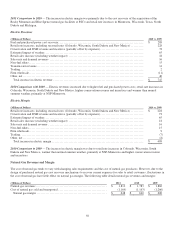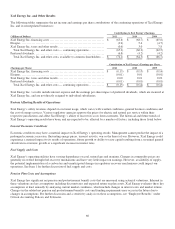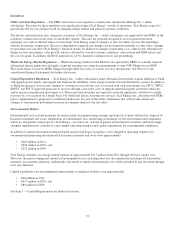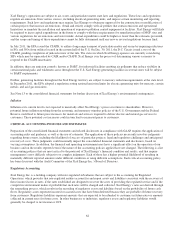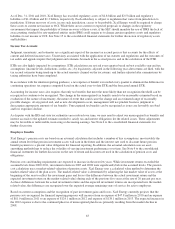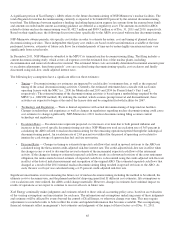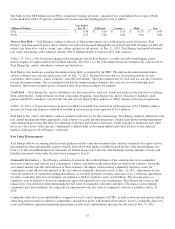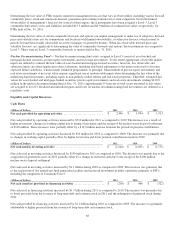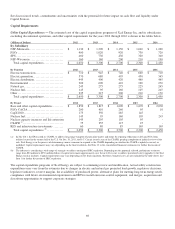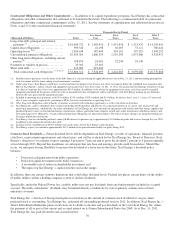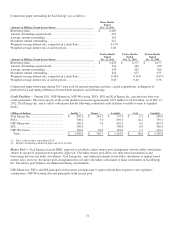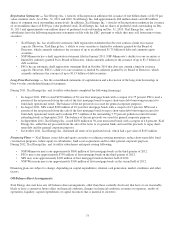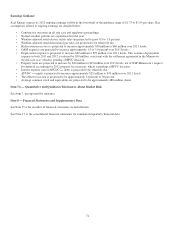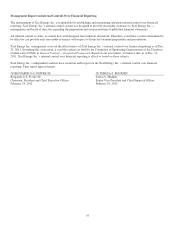Xcel Energy 2011 Annual Report Download - page 75
Download and view the complete annual report
Please find page 75 of the 2011 Xcel Energy annual report below. You can navigate through the pages in the report by either clicking on the pages listed below, or by using the keyword search tool below to find specific information within the annual report.
65
A significant portion of Xcel Energy’s AROs relates to the future decommissioning of NSP-Minnesota’s nuclear facilities. The
total obligation for nuclear decommissioning currently is expected to be funded 100 percent by the external decommissioning
trust fund. The difference between regulatory funding (including depreciation expense less returns from the external trust fund)
and amounts recorded under current accounting guidance are deferred as a regulatory asset. The amounts recorded for AROs
related to future nuclear decommissioning were $1,482.7 million and $809.5 million as of Dec. 31, 2011 and 2010, respectively.
Based on their significance, the following discussion relates specifically to the AROs associated with nuclear decommissioning.
NSP-Minnesota obtains periodic site-specific cost studies in order to estimate the nature, cost and timing of planned nuclear
decommissioning activities. These independent third party cost studies are based on relevant information available at the time
performed; however, estimates of future cash flows for extended periods of time are by nature highly uncertain and may vary
significantly from actual results.
In December 2011, NSP-Minnesota submitted to the MPUC its triennial nuclear decommissioning filing. The filing includes a
current decommissioning study, which covers all expenses over the estimated lives of the nuclear plants, including
decontamination and removal of radioactive material. The estimated future costs are initially determined in nominal amounts prior
to escalation adjustments, then future periods’ costs are escalated using decommissioning-specific cost escalators and finally
discounted using risk-free, credit adjusted interest rates.
The following key assumptions have a significant effect on these estimates:
• Timing — Decommissioning cost estimates are impacted by each facility’s retirement date, as well as the expected
timing of the actual decommissioning activities. Currently, the estimated retirement dates coincide with each units
operating license with the NRC (i.e., 2030 for Monticello and 2033 and 2034 for Prairie Island’s Unit 1 and 2,
respectively). The estimated timing of the decommissioning activities is based upon a methodology required by the
MPUC (i.e., DECON method). By utilizing this method, which assumes prompt removal and dismantlement, these
activities are expected to begin at the end of the license date and be completed for both facilities by 2067.
• Technology and Regulation — There is limited experience with actual decommissioning of large nuclear facilities.
Changes in technology and experience as well as changes in regulations regarding nuclear decommissioning could cause
cost estimates to change significantly. NSP-Minnesota’s 2011 nuclear decommissioning filing assumes current
technology and regulations.
• Escalation Rates — Escalation rates represent projected cost increases over time due to both general inflation and
increases in the cost of specific decommissioning activities. NSP-Minnesota used an escalation rate of 3.63 percent in
calculating the AROs related to nuclear decommissioning for the remaining operational period through the radiological
decommissioning period. An escalation rate of 2.63 percent was utilized for the period of operating costs related to
interim dry cask storage of spent nuclear fuel and site restoration.
• Discount Rates — Changes in timing or estimated expected cash flows that result in upward revisions to the ARO are
calculated using the then-current credit-adjusted risk-free interest rate. The credit-adjusted risk-free rate in effect when
the change occurs is used to discount the revised estimate of the incremental expected cash flows of the retirement
activity. If the change in timing or estimated expected cash flows results in a downward revision of the asset retirement
obligation, the undiscounted revised estimate of expected cash flows is discounted using the credit-adjusted risk-free rate
in effect at the date of initial measurement and recognition of the original ARO. The estimated expected cash flows that
changed as a result of the 2011 triennial nuclear decommissioning filing resulted in upward revisions to the ARO. As
such, the new cost layer was calculated using a 4.33 percent credit-adjusted risk-free rate.
Significant uncertainties exist in estimating the future cost of nuclear decommissioning including the method to be utilized, the
ultimate costs to decommission, and the planned method of disposing spent fuel. If different cost estimates, life assumptions or
cost escalation rates were utilized, the AROs could change materially. However, changes in estimates have minimal impact on
results of operations as we expect to continue to recover all costs in future rates.
Xcel Energy continually makes judgments and estimates related to these critical accounting policy areas, based on an evaluation
of the varying assumptions and uncertainties for each area. The information and assumptions underlying many of these judgments
and estimates will be affected by events beyond the control of Xcel Energy, or otherwise change over time. This may require
adjustments to recorded results to better reflect the events and updated information that becomes available. The accompanying
financial statements reflect management’s best estimates and judgments of the impact of these factors as of Dec. 31, 2011.



